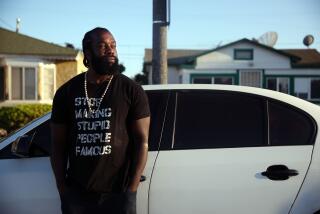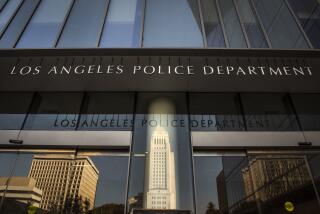Editorial: LAPD’s examination of racial profiling must continue
- Share via
Thanks to the 4th Amendment’s protections against unreasonable search and seizure, police generally can’t arrest or search anyone without first having probable cause to believe the subject is involved in a crime. But nearly 50 years ago in the case of Terry v. Ohio, the Supreme Court recognized a way for officers to conduct limited searches while still complying with the 4th amendment’s restrictions.
An officer might lack probable cause, but if he has a lower yet still reasonable level of suspicion, he can “stop” the person without making an arrest. No real search is allowed. Yet because the encounter with a possible suspect puts the officer in potential danger, he can conduct a quick pat-down for weapons — a “frisk” — to protect himself.
Stop-and-frisks became news over the last decade when some New Yorkers — chiefly young African American men — found themselves being stopped on a regular basis. Very often, the only “suspicion” that warranted the intrusion appeared to be that the subjects were young, black, male and living in high-crime neighborhoods.
A survey commissioned by the LAPD in September showed that far fewer African Americans have confidence in police than do Latinos, Asians or whites.
In other words, the police were racially profiling them and using Terry stops as a pretext to carry out a program of unlawful searches. A federal court found the New York practice unconstitutional.
During his campaign, Donald Trump praised aggressive stop-and-frisk and criticized the “very against-police judge” for ordering changes to the New York program. He also asserted that Mayor Bill de Blasio ended stop-and-frisk in New York altogether — which is false — and that since the court ruling, homicides in that city had increased — also false.
Los Angeles has a different pattern of living and policing. More people have cars, and there are fewer police officers per resident.
However, as the Police Commission heard during a long Tuesday session devoted to racial profiling, many African Americans, especially young men, describe their encounters with police in much the same way as their New York counterparts. The difference is that the encounters often come in the form of vehicle stops. But the feeling of unwarranted intrusion, of violation, of harassment, of being racially profiled, is much the same.
A survey commissioned by the LAPD in September showed that far fewer African Americans have confidence in police than do Latinos, Asians or whites.
The numbers are striking, but in no way surprising. Similar studies and surveys conducted over decades show similar disparities, and for the same reasons: African Americans are policed differently than others.
The confidence gap persists even though policing in Los Angeles has radically changed over the last 20 years. Practices were overhauled under a consent decree that lasted from 2001 to 2013. Explicit bias is generally weeded out in the recruitment and hiring process. The ranks of officers are now far more ethnically and racially representative of the city’s people than are many other civic institutions.
One thing that hasn’t changed, though, is that the LAPD still has too few officers to engage in true community policing, in which police walk beats and become personally acquainted with the people they protect. The department must instead periodically redeploy its relatively small force to areas that experience spikes of violent crime — and historically those spikes have plagued some African American and Latino neighborhoods more than others.
Patrol officers look for weapons and other evidence of crime, and are likely to be on alert for cars with broken taillights, or making illegal turns, that they can lawfully stop. They can’t frisk a car, but they can ask for permission to search it. Do they just happen to notice more broken taillights on cars driven by young African American men, or is there a more insidious explanation for the disproportionate number of stops?
The Police Commission took a good first step in holding a conversation on racial profiling and giving some public airing to the gulf that separates police from many of the communities they patrol. The survey is useful as well, even if few of the findings are particularly new.
The commissioners now ought to drill further down into the numbers. Do stops, frisks and car searches of African Americans and Latinos turn up more evidence of crime than they do for whites? When officers stop white drivers for making an illegal turn, do they ask for permission to search the car as often as they do with black drivers? Are more or fewer African Americans who are stopped for driving with broken taillights ordered to get out of their cars? Certainly there are reasons for different police practices in different areas, but what the commission and the rest of us really need to know is whether the disparity is necessary and justifiable in fighting crime, and whether the cost — the continuing mistrust and anger — is worth it.
Follow the Opinion section on Twitter @latimesopinion and Facebook
More to Read
A cure for the common opinion
Get thought-provoking perspectives with our weekly newsletter.
You may occasionally receive promotional content from the Los Angeles Times.










